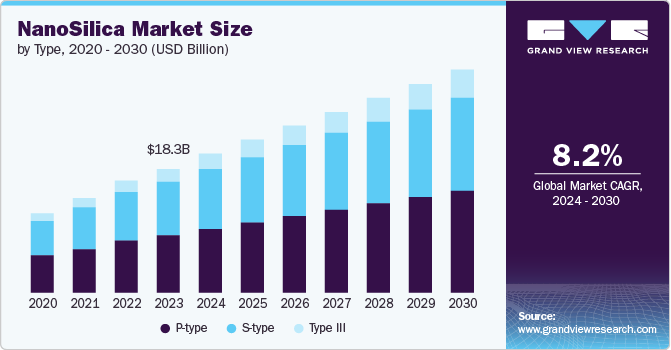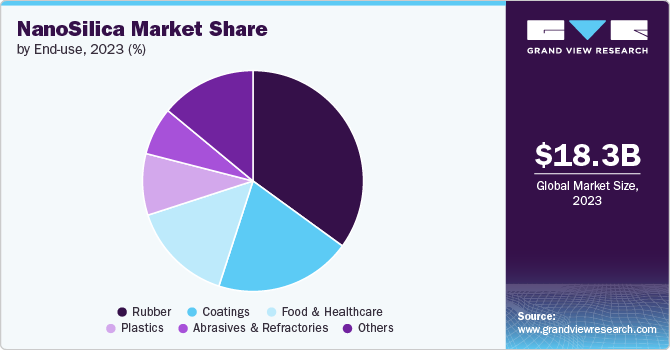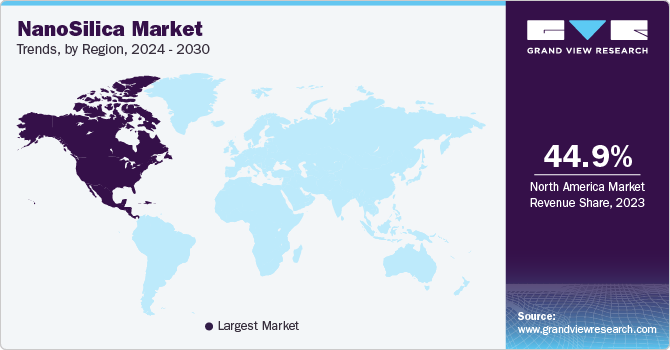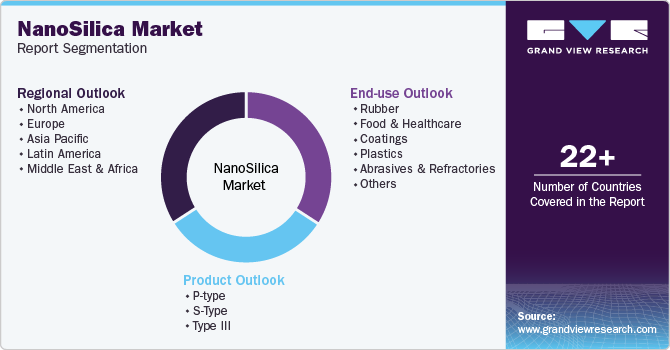
NanoSilica Market Size, Share & Trends Analysis By Product (P Type, S Type, Type III), By End-use (Rubber, Food & Healthcare, Coatings, Plastics, Abrasives & Refractories), By Region, And Segment Forecasts, 2024 - 2030
- Report ID: GVR-1-68038-808-4
- Number of Report Pages: 100
- Format: PDF, Horizon Databook
- Historical Range: 2018 - 2022
- Forecast Period: 2024 - 2030
- Industry: Advanced Materials
NanoSilica Market Size & Trends
The global nanosilica market was valued at USD 18.3 billion in 2023 and is expected to grow at a CAGR of 8.2% from 2024 to 2030. The growth is attributable to the rise in the demand for nanocoating across aviation, automobile, and medical industries. Manufacturers have increasingly used nanosilica to enhance moisture and bacteria resistance, UV damage, and abrasion in nanocoatings. Aerospace equipment benefits from metal nanocoatings that shield it from temperature fluctuations, minor scratches, and water damage with their ability to protect against corrosion and oxidation.

The robust expansion of electronics and healthcare industries which increasingly applied nanosilica is a key market driver. The material’s tiny particle size and large surface area are valued for enhancing the performance of electronics in terms of conductivity, durability, and thermal stability. In healthcare settings, nanosilica is applied in drug delivery systems, wound healing, and diagnostic tools.
Furthermore, the market was fueled by material science advancements. Companies including PPG Industries and NanoPore Incorporated have increasingly recognized the potential of nanosilica in influencing the future of materials science. This has led market players to invest in R&D efforts related to nanotechnology and material science and introduce innovative manufacturing processes.
In addition, concerns about environmental impact have resulted in a shift toward eco-friendly formulations. Nanosilica offers an alternative to green technology owing to its unique properties such as tiny particle size and large surface area. The market has witnessed businesses increasingly segmenting the advanced material’s properties to assess its potential across various industries and enhance products and applications.
Product Insights
The P-type variant products have registered the dominant market share with 46.6% in 2023 owing to its numerous nanopores with a pore rate of 0.61 ml/g. These variants exhibit a higher ultraviolet reflectivity. These properties make them valuable for enhancing material performance in various industries including construction. P-type nanosilica is an excellent admixture for concrete as it leads to better engineering properties. It reduces thermal cracking caused by the heat of cement hydration, improves durability to attack by sulfate and acidic waters, and increases strength.
Type III variants are expected to emerge as the fastest-growing segment during the forecast period. These particles have less surface area than P-type particles and are applied as a stable, non-toxic platform for biomedical applications. These are applied in drug delivery systems, wound healing, and diagnostic tools in the healthcare setting. The material’s biocompatibility and ability to improve drug efficacy make it preferable for medical devices and pharmaceuticals. The construction industry favors nanosilica due to its low volatile organic content (VOC). Type III Nanosilica enhances concrete strength, durability, self-healing capabilities, and air purification when added to coatings. Furthermore, researchers and manufacturers have increasingly focused on innovative manufacturing techniques for type III nanosilica to improve production efficiency, quality, and cost-effectiveness.
End-use Insights
The rubber industry has secured the dominant market share in 2023 owing to nanosilica’s role in enhancing material properties. Its small particle size and large surface area improved rubber reinforcement, durability, and resistance to wear and tear. The automotive sector significantly contributed to the demand for rubber products. Nanosilica-enhanced rubber compounds were extensively applied in tires, seals, and gaskets to improve tire performance, reduce rolling resistance, and enhance fuel efficiency were key benefits. Furthermore, the construction industry has relied on rubber materials for nanosilica-modified rubber sealants, adhesives, and coatings. These provide better weather resistance, flexibility, and durability. These properties were essential for construction joints, roofing, and other structural elements.

Coatings are anticipated to grow substantially at a CAGR of 10.3% over the forecast period owing to the increasing demand for nanocoating across aviation, automobile, and medical industries. The material’s ability to enhance resistance to moisture, UV damage, and abrasion made it an ideal ingredient in various coating compositions. For instance, coatings used in medical devices, wound healing, and diagnostic tools benefited from nanosilica’s biocompatibility and ability to improve material properties with wear resistance and durability.
Regional Trends
The nanosilica market in Asia Pacific region secured a market share of 44.9% owing to its rising demand in countries including China, Japan, and India. The increasing number of buildings and construction activity in the region fueled the demand for nanosilica. Construction materials benefited from nanosilica’s properties, such as improved durability, wear resistance, and environmental sustainability. In addition, nanosilica-modified coatings gained prominence in the paint and coatings industry. These coatings provided better weather resistance, flexibility, and durability, contributing to market expansion.
North America NanoSilica Market Trends
The North America nanosilica market registered a market share of 22.6% in 2023 due to the growing adoption of next-generation technologies across various end-use sectors. This trend fueled demand for nanosilica, especially in applications related to rubber and plastic additives, automotive components, and construction materials. Nanosilica-enhanced rubber compounds are applied in tires, seals, gaskets, and other automotive components for durability, improved tire performance, reduced rolling resistance, and enhanced fuel efficiency.

U.S. NanoSilica Market Trends
The nanosilica market in U.S. was propelled by the growing demand for nanocoating across aviation, automobile, and medical industries. The market has witnessed several companies heavily investing in research and development efforts to advance nanotechnology and material science to innovate novel applications for nanosilica.
Europe NanoSilica Market Trends
The Europe nanosilica market held 18.3% of the market share in 2023. The demand was primarily driven by concerns about environmental impact, leading to a shift into eco-friendly formulations. Nanosilica gained considerable traction with its potential for green technology. Furthermore, ongoing research and development focused on innovative manufacturing techniques for nanosilica to improve production efficiency, quality, and cost-effectiveness.
Key NanoSilica Company Insights
Key players such as AkzoNobel N.V., Cabot Corporation, Evonik Industries, and others are capitalizing on their robust resources and market influence to drive technological advancements and expand their product offerings
-
AkzoNobel N.V. is a Dutch multinational company that specializes in creating paints and performance coatings for both industry and consumers worldwide. The company’s portfolio of brands includes Dulux, International, Sikkens, and Interpon.
-
Cabot Corporation is a global specialty chemicals & performance materials company that delivers innovative solutions to customers across various industries, including transportation, infrastructure, environment, and consumer goods. The company offers reinforcing carbons, battery materials, engineered elastomer composites, specialty carbons, fumed metal oxides, masterbatches, conductive compounds, inkjet colorants, and aerogel.
Key NanoSilica Companies:
The following are the leading companies in the nanosilica market. These companies collectively hold the largest market share and dictate industry trends.
- Evonik Industries
- AkzoNobel N.V.
- E. I. du Pont de Nemours and Company
- Cabot Corporation
- NanoPore Incorporated
- Nanostructured & Amorphous Materials, Inc. (NanoAmor)
- Fuso Chemical Co. Ltd.
- Wacker Chemie AG
- Dow Corning Corporation
- Bee Chems
Recent Development
-
In November 2023, AzkoNobel launched the initial two products from its new Accelstyle range for its packing coating business. These products are specifically designed for the outer surface of traditional two-piece aluminum beverage cans and are formulated without bisphenols, styrene, and PFAS (per- and polyfluoroalkyl substances)
NanoSilica Market Report Scope
|
Report Attribute |
Details |
|
Market size value in 2024 |
USD 20.3 billion |
|
Revenue forecast in 2030 |
USD 32.7 billion |
|
Growth rate |
CAGR of 8.2% from 2024 to 2030 |
|
Base year for estimation |
2023 |
|
Historical data |
2018 - 2022 |
|
Forecast period |
2024 - 2030 |
|
Quantitative units |
Volume in Kilotons, revenue in USD million and CAGR from 2024 to 2030 |
|
Report coverage |
Revenue forecast, company ranking, competitive landscape, growth factors, and trends |
|
Segments covered |
Product, end-use, region |
|
Regional scope |
North America; Europe; Asia Pacific; Latin America; MEA |
|
Country scope |
U.S.; Canada; Mexico; Germany; UK; France; Italy; Spain. China; India; Vietnam; Thailand; South Korea; Brazil; Argentina; South Africa; Saudi Arabia |
|
Key companies profiled |
Evonik Industries; AkzoNobel N.V.; E. I. du Pont de Nemours and Company; Cabot Corporation; NanoPore Incorporated; Nanostructured & Amorphous Materials, Inc. (NanoAmor); Fuso Chemical Co. Ltd.; Wacker Chemie AG; Dow Corning Corporation; Bee Chems |
|
Customization scope |
Free report customization (equivalent up to 8 analysts working days) with purchase. Addition or alteration to country, regional & segment scope. |
|
Pricing and purchase options |
Avail customized purchase options to meet your exact research needs. Explore purchase options |
Global NanoSilica Market Report Segmentation
This report forecasts revenue growth at global, regional, and country levels and provides an analysis of the latest industry trends in each of the sub-segments from 2018 to 2030. For this study, Grand View Research has segmented the global nanosilica market report based on product, end-use, and region.

-
Product Outlook (Revenue, USD Million, 2018 - 2030) (Volume in Kilotons)
-
P-type
-
S-Type
-
Type III
-
-
End-use Outlook (Revenue, USD Million, 2018 - 2030) (Volume in Kilotons)
-
Rubber
-
Food & healthcare
-
Coatings
-
Plastics
-
Abrasives & refractories
-
Others
-
-
Regional Outlook (Revenue, USD Million, 2018 - 2030)
-
North America
-
U.S.
-
Canada
-
Mexico
-
-
Europe
-
Germany
-
UK
-
France
-
Italy
-
Spain
-
-
Asia Pacific
-
China
-
India
-
Vietnam
-
Thailand
-
South Korea
-
-
Latin America
-
Brazil
-
Argentina
-
-
Middle East and Africa (MEA)
-
Saudi Arabia
-
-
We are committed towards customer satisfaction, and quality service.
"The quality of research they have done for us has been excellent."




